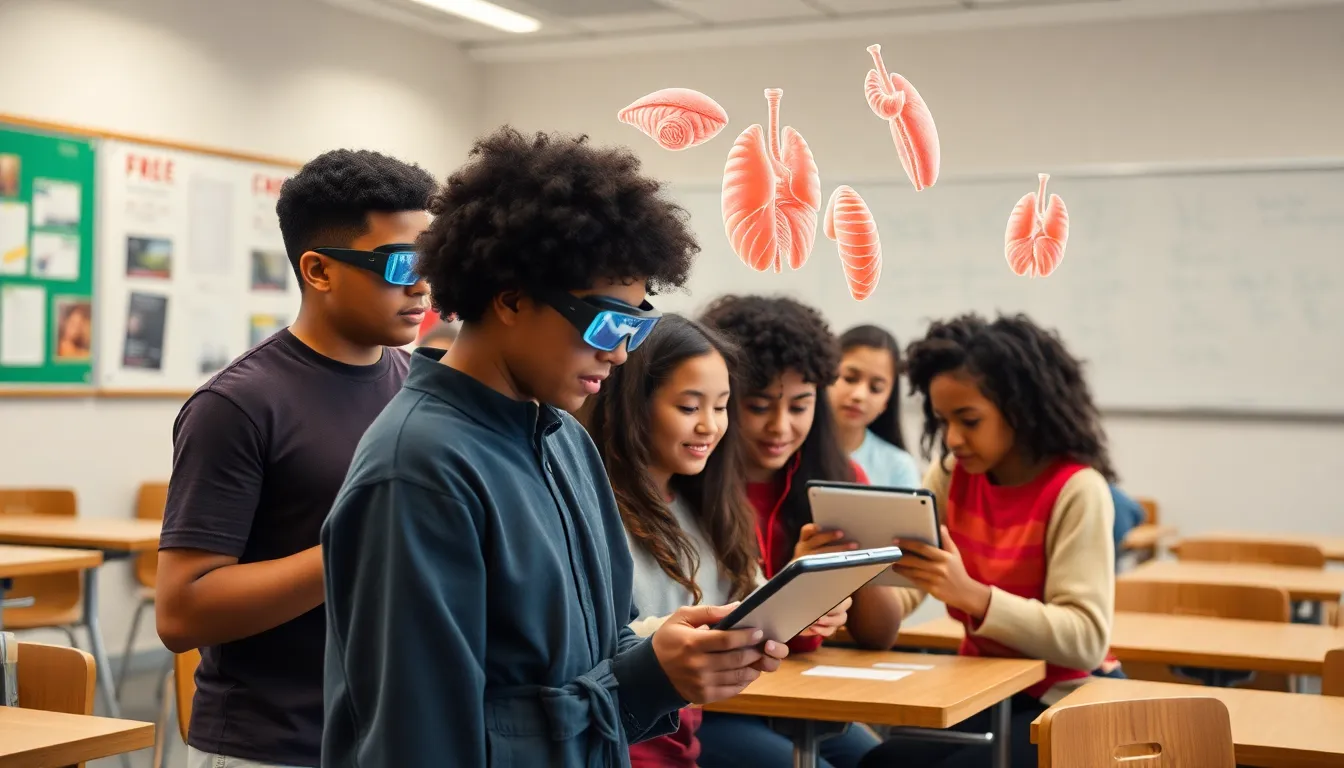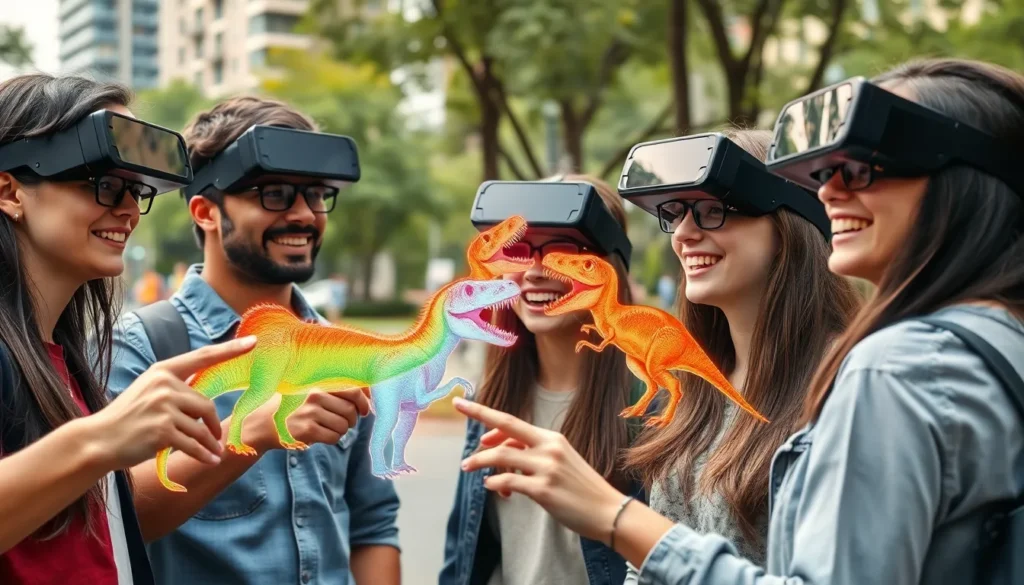Imagine walking down the street and suddenly seeing a dinosaur strutting past you, or your favorite cartoon character popping up to give you a high-five. Welcome to the world of Augmented Reality (AR), where the impossible becomes possible and everyday life gets a sprinkle of magic. This thrilling technology overlays digital information onto the real world, turning mundane moments into unforgettable experiences.
AR isn’t just for gamers or tech enthusiasts; it’s transforming industries from retail to education. Whether it’s trying on clothes virtually or visualizing how a new sofa fits in your living room, AR makes decision-making easier and way more fun. So, buckle up as we dive into the fascinating realm of Augmented Reality, where reality gets a much-needed upgrade and creativity knows no bounds.
Table of Contents
ToggleOverview of Augmented Reality
Augmented Reality (AR) merges the digital and physical worlds, providing users with interactive experiences by superimposing digital elements onto their real surroundings. This unique technology enhances both engagement and accessibility across various sectors.
Definition and Concept
Augmented Reality refers to technology that overlays computer-generated images, sounds, or data onto the real world. AR enhances real-time interactions by integrating virtual components into actual environments. Using devices like smartphones, tablets, and AR glasses, users interact with their surroundings enriched by digital content. Applications range from interactive educational tools to navigation aids. The technology operates through computer vision, simultaneous localization, and mapping algorithms, enabling accurate positioning of digital elements within a physical space.
Historical Background
The roots of Augmented Reality trace back to the 1960s, with Ivan Sutherland’s “Ultimate Display” concept, which showcased the potential of computer-generated environments. By the 1990s, AR gained traction through military applications and research projects. The introduction of the first AR headset by Boeing marked a significant shift, allowing engineers to visualize complex components during assembly. Fast forward to the 2000s, and AR started penetrating consumer markets with mobile applications like Layar and Pokémon GO, popularizing its widespread use and establishing a foundation for further advancements.
Applications of Augmented Reality

Augmented Reality (AR) finds diverse applications across multiple sectors, enhancing various experiences.
In Education
AR transforms the educational landscape by providing interactive learning experiences. Students engage with subjects in an immersive manner, exploring complex concepts visually. For instance, anatomy students can visualize 3D models of human organs through AR applications. Such tools promote deeper understanding and retention of knowledge. Additionally, AR enables real-time feedback, allowing educators to assess comprehension instantly. Learning becomes more engaging, increasing motivation among students.
In Healthcare
Healthcare professionals utilize AR for enhanced training and surgical procedures. Surgeons benefit from AR overlays that display critical information during operations. This technology can project patients’ medical histories or vital signs, improving decision-making. Apart from training, AR also aids in patient education; physicians can illustrate procedures before they happen. By visualizing treatments, patients feel more informed and comfortable. Overall, AR streamlines workflows, ultimately leading to better care.
In Entertainment
The entertainment industry leverages AR to create immersive experiences. Gamers interact with digital characters in real-world environments, enhancing gameplay. Popular examples include mobile games that use location-based features, captivating users. Beyond gaming, AR enriches live events, providing fans with dynamic content during concerts or sports. Furthermore, AR experiences can transform traditional media, blending physical books or displays with digital enhancements. Enabling these interactions results in memorable entertainment experiences.
Benefits of Augmented Reality
Augmented Reality (AR) delivers numerous advantages across various sectors. Its impact on user experience and learning outcomes stands out prominently.
Enhanced User Experience
AR significantly elevates user experiences. It allows individuals to engage interactively with products, providing virtual try-ons for clothing or makeup. When shopping, customers can visualize how an item fits or looks in their environment, reducing uncertainty during purchases. Gamers can immerse themselves in enriched environments, blending digital elements with reality for engaging gameplay. This technology also fosters social connections through shared experiences, as users interact with both physical and digital objects. Enhanced navigation assistance using AR leads to more efficient travel, guiding users with real-time directions layered on their surroundings.
Improved Learning Outcomes
AR transforms the educational landscape remarkably. It offers visual aids that simplify complex subjects, making learning more engaging. Students benefit from interactive lessons, allowing them to explore 3D models in real-time, such as dissecting virtual human organs during anatomy studies. Teachers can create immersive learning scenarios that capture students’ attention better than traditional methods. Enhanced retention rates emerge as educators leverage AR tools, connecting theoretical knowledge to practical applications. AR promotes collaborative learning, enabling students to work together in shared virtual spaces, enhancing teamwork and communication skills.
Challenges and Limitations
Augmented Reality (AR) faces various challenges that hinder its widespread adoption and effectiveness. Key areas include technical hurdles and privacy concerns.
Technical Hurdles
Developers encounter numerous technical hurdles in AR implementation. Device compatibility remains a significant issue, as different hardware produces varied experiences. Processing power directly influences AR’s quality; lower-end devices may struggle with running complex applications. Network connectivity affects real-time interactions; inconsistent Wi-Fi or mobile data can lead to lag or interrupted experiences. Users might also experience discomfort due to motion sickness caused by mismatched visual and physical movements, affecting usability. These challenges persist as developers aim to create smoother and more accessible AR experiences.
Privacy Concerns
Privacy concerns pose substantial obstacles for AR adoption. AR applications often require user data for personalization and functionality, raising questions about data security. Users might feel uncomfortable sharing their location and personal preferences, fearing misuse or breaches. The potential for misuse increases when AR integrates with social media platforms, complicating users’ control over their information. Regulations on data protection are vital to ensure users are informed about data usage. Addressing these privacy issues can promote trust and lead to more widespread acceptance of AR technology.
Future Trends in Augmented Reality
Augmented Reality continues to evolve, shaping how people engage with technology. Several trends are emerging that highlight its potential.
Advancements in Technology
Innovations in hardware play a critical role in AR’s future. Companies like Microsoft and Apple are investing in advanced AR glasses and headsets that seamlessly integrate digital content into daily life. Improved software development kits allow developers to create more immersive experiences with greater interactivity. Cloud computing is transforming AR applications by enabling more complex data processing and storage, enhancing real-time performance. Furthermore, 5G connectivity significantly increases slow data transfer speeds, reducing the lag in performance. These technological advancements pave the way for practical applications in various sectors, such as education, healthcare, and retail.
Potential Market Growth
Projected market growth for AR indicates strong potential. Analysts predict that the AR market will reach approximately $198 billion by 2025, reflecting significant investment and interest. Industries like retail and real estate are already incorporating AR for virtual try-ons and property walkthroughs, respectively. Businesses recognize the value of enhancing customer experiences, increasing engagement, and driving sales. Moreover, as more consumers adopt AR-capable devices, demand continues to rise. Engaging marketing strategies that leverage AR will further accelerate this growth, transforming how brands connect with their audiences.
Augmented Reality is reshaping how individuals interact with their surroundings by blending the digital and physical worlds. Its impact spans various sectors from education to healthcare and retail, enhancing user experiences and decision-making processes. As technology continues to advance, AR’s potential will only expand, offering more immersive and engaging interactions.
While challenges like privacy concerns and technical limitations remain, ongoing innovations promise to address these issues. The future of AR looks bright with projected market growth and increasing adoption across industries. As brands harness AR’s capabilities, the way people connect with products and experiences will transform, making everyday life more interactive and enjoyable.






